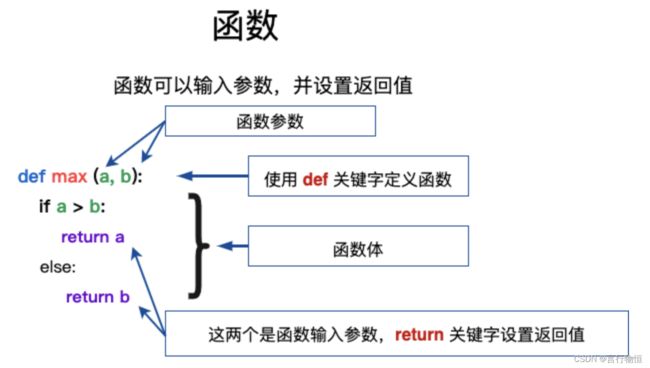Python学习笔记——基本类型、函数、输入和输出
- 食用说明:本笔记适用于有一定编程基础的伙伴们。希望有助于各位!
基础类型
常用的简单类型有str,float,int,bool等,常见的复杂数据类型有function,type,list,tuple,dict,set等。具体如下:
# 全部变量类型
num1 = 0
print(type(num1), num1)
num2 = 1.0
print(type(num2), num2)
str1 = 'hello'
print(type(str1), str1)
# 转义标志
str1 = '\'hello\''
# 多行定义
str1 = """
hello,
friend
"""
bool1 = True
print(type(bool1), bool1)
none1 = None
print(type(none1), none1)
def func1():
print('hello')
print(type(func1))
class Person:
def __init__(self, name, age):
self.name = name
self.age = age
def greet(self):
print(f"hello, {self.name}")
print(type(Person))
# 列表的相同类型元素定义
list1 = [1, 2, 3, 4, 5]
print(type(list1), list1)
# 列表的不同类型元素定义
list2 = [1, 2, True, [1, 2]]
print(type(list2), list2)
# 元组,相同类型元素
tuple1 = (1, 2, 3, 4, 5)
print(type(tuple1), tuple1)
# 元组,不同类型元素
tuple2 = (1, (1, 2), [1, 2], True)
print(type(tuple2), tuple2)
# 字典类型
dict1 = {'name': '张三', 'age': 18}
print(type(dict1), dict1)
# 集合类型
set1 = {1, 2, 3}
print(type(set1), set1)
# 集合类型,不同类型元素
set2 = {1, True, '张三', 1.2, func1}
print(type(set2), set2)- 元组和列表相似,但无法修改。
- 集合只能加入简单数据,无法加入可迭代数据,如字典类型,列表类型,集合类型以及元组类型。
- 以上包含了大部分常用类型的定义和简单使用,可自行尝试。
函数(方法)定义
常规的函数定义结构如下:
从上图可知:
- 函数的声明需要使用def关键字。
- 函数必须拥有一个函数名,且包含参数括号,用于声明。
函数定义可以使用类型定义,具体如下:
def func1(a: float | int, b: int) -> float:
return a + b这一类型定义的方法与typescript类似,当然也有一定区别:
- 定义参数类型时使用‘:’作为引导符,使用‘->’作为返回值引导符
- 当出现多个参数类型定义时,可以使用‘|’作为分割符
另外参数如果为方法,同样可以用到类型定义,具体如下:
def func2(a: float, b: float, cb: callable) -> float:
cb(a, b)
return a + b
func2(1, 2, func1)输入和输出
任何语言都有其独特的输入和输出语句,python固然拥有:
username = input()
password = input()
print(f'your username:{username},your password:{password}!')
- input()是一个控制台输入方法,用于接受用户输入
- print()是一个控制台输出方法,用于输出特定内容
- 使用f前置可以让输出字串格式化,格式化标志是{},在花括号内部的即变量
同时,输出格式化字串的方法不止一种,下面的方法也是不错的选择:
username = input()
password = input()
print(f'your username:{username},your password:{password}!')
print('your username:%s,your password:%s!' % (username, password))- 使用%格式化标志用于替换格式化字串,通常%s是字串格式化,而跟随字串之后的就是实际变量,也使用%隔开。
- %格式方式可以定义字串的样式,如字宽,精度控制等,如下:
name = "Polaris"
age = 12.0178
# 格式化方式,浮点数格式化m.n,m是宽度,n是小数精度控制(四舍五入)
words = "hello, %s, age: %10.4f" % (name, age)